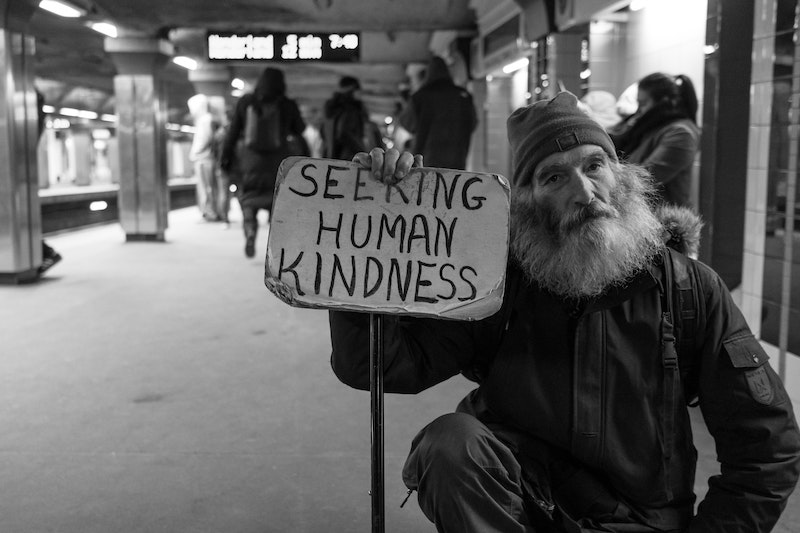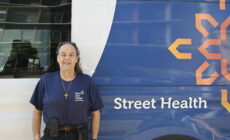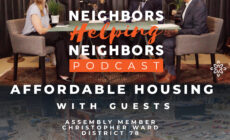
Table of Contents
Common Myths and Stereotypes of Homelessness
People experiencing homelessness are often negatively misrepresented in our society. They are characterized as dangerous criminals worthy of incarceration, or sad figures suffering from severe mental illness who are beyond help.
Many people don’t realize that, in fact, there are many faces of homelessness– from people overcoming substance-use disorder and those living with mental illness to veterans struggling to readjust to civilian life and families who can’t make ends meet.
Overall, stereotypes of homelessness tend to fault people who are homeless for their situation. In actuality, homelessness is as diverse as any other population. Many people become homeless because they can no longer afford their rent—whether that’s because of job loss, health issues, addiction, death in the family, rent increase, or a host of other reasons.
What are the Stereotypes of Homelessness?
People experiencing homelessness all have mental health issues or substance use disorders.
Because the relatively small number of people living on the streets who suffer from paranoia, delusions and other mental disorders are very visible, they have become the stereotype for the entire homeless population.
While some of those we serve at Father Joe’s Villages are people struggling with mental health issues and substance use disorders, there is a myriad of reasons people become homeless.
Domestic violence is the leading cause of homelessness among women
According to Safe Housing Partnerships, thirty-eight percent of all domestic violence victims become homeless at some point in their lives. Many abuse survivors don’t have a strong support system they can rely on and must therefore seek supportive housing and health care resources from state-run agencies or organizations.
In 2016, the National Network to End Domestic Violence recorded over 41,000 adults and children across the country fleeing domestic violence found refuge in an emergency shelter or transitional housing program. Those escaping abusive conditions would rather take their chances in a homeless shelter or on the streets than remain trapped in consistently violent homes.
Systemic racism underlies disproportionate levels of homelessness in Black, Indigenous and People of Color
Systematic racism is another factor that underlies disproportionate levels of homelessness in Black, Indigenous and People of Color (BIPOC) communities. For example, a practice from the 1930s called redlining allowed government-backed bodies to mark maps of minority communities in red and label them as poor financial investments. These deliberately oppressive policies are still felt by the residents in neighborhoods that were redlined nationwide.
Census data shows that Black households pay unaffordable rents and mortgages more frequently than white households: in 2016 in California, more than 60% of Black renters paid more than 30% of their income to housing.
According to the California Coalition for Youth, based on national surveys, between 1.6 and 2.1 million youth ages 12-24 are homeless over the course of a year. Many of these youths are homeless because they are fleeing discrimination and abuse at home. They often don’t have the familial safety net or resources that would prevent them from falling into homelessness.
It is estimated that lesbian, gay, bisexual and transgender (LGBTQI+) youth make up thirty-nine percent of the street youth population. LGBTQI+ youth leave home more frequently and are exposed to more victimization while on the streets compared to heterosexual homeless youth.
People want to be homeless
Often, people experience homelessness when they are dealing with circumstances that make it difficult to maintain housing stability and all other options have been exhausted.
At its core, San Diego’s homelessness crisis is a housing crisis.
With record-breaking rent prices and the nation’s lowest vacancy rate, affordable housing is the largest barrier to solving homelessness in our city—and other cities across the country are starting to struggle with the same issues.
The National Law Center on Homelessness and Poverty (NLCHP) reported that in 2012, there were 10.3 million renters across the country whose income was low enough to earn the HUD classification of “extremely low income.” Meanwhile, only 5.8 million rental units were available that the over 10 million ELI individuals could afford. And, on top of that, out of every 100 units, only one was available.
Those figures have only gotten worse since then. The Census Bureau showed that in June of 2020, roughly 65 million non-elderly people lived with families whose total weekly earnings fell below the poverty line.
For years, rents have increased while wages have remained stagnant making job loss the second leading cause of homelessness. Startlingly, in 2019, Charles Schwab reported in their “Modern Wealth Survey” that 59% of Americans are just one paycheck away from homelessness.
Few people want to be homeless. For an overwhelming number of the population just one unforeseen emergency can lead to homelessness.
People who are homeless are lazy
When Pamela, a former Father Joe’s Villages resident, could no longer afford her apartment on her fixed income, she moved into a tent in an empty field in San Diego. At 59 years old, Pamela’s days became consumed with searching for food and hauling heavy buckets of water to her tent so she could drink and bathe.
In order to survive, many people who experience homelessness are constantly in search for the necessities of life, such as food, shelter and a source of income. Therefore, due to the barriers that they face, many people experiencing homelessness do not even have the option to be lazy, since they are focused on survival.
Many individuals suffering from illnesses and/or disabilities physically cannot work. In San Diego, according to the Regional Task Force on the Homeless (RTFH) Point-in-Time We All Count Report, 58% of those who are unsheltered have a disability as compared to 10% of the general population. 32% of those individuals have chronic illness.
Even worse, people living on the streets often have co-occurring conditions, including multiple chronic and disabling health and behavioral health conditions. These conditions prohibit these individuals from gaining employment
The Harm of the Stigma Around Homelessness
Negative stereotypes and dehumanization can increase discrimination, violence, and hate crimes against people who are homeless. When we objectify or dehumanize, it can make it easier to treat people poorly. Eliminating stereotypes associated with homelessness helps to humanize homeless individuals and promotes effective change through empathy.
We cannot define people solely by their homelessness. Each person experiencing homelessness contains a multitude: They are mothers, fathers, sisters, brothers, sons, daughters, artists, writers, businesspersons, entrepreneurs, athletes, and so much more.
We must see the person for who they truly are rather than the stigma society has created of them if we truly wish to prevent and end homelessness.





